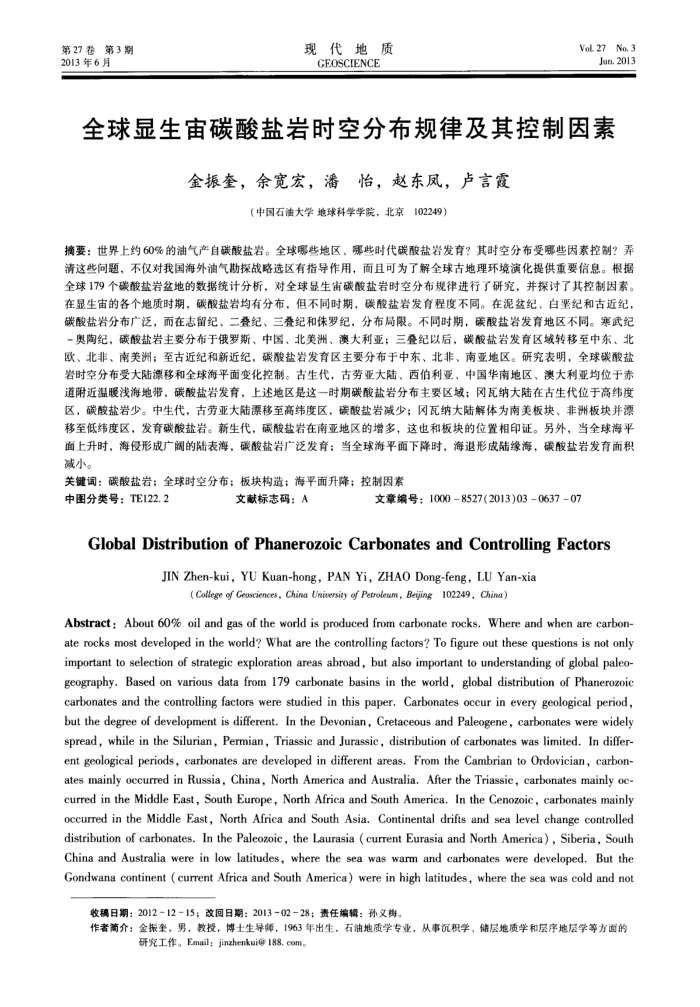全球显生宙碳酸盐岩时空分布规律及其控制因素
内容简介
 第27卷第3期 2013年6月
第27卷第3期 2013年6月现代地质 GEOSCIENCE
Vol. 27 No. 3 Jun.2013
全球显生宙碳酸盐岩时空分布规律及其控制因素
金振奎,余宽宏,潘怡,赵东凤,卢言霞
(中国石油大学地球科学学院,北京102249)
摘要:世界上约60%的油气产自碳酸盐岩。全球哪些地区、哪些时代碳酸盐岩发育?其时空分布受哪些因素控制?弄清这些间题,不仅对我国海外油气勘探战略选区有指导作用,面且可为了解全球古地理环境演化提供重要信息。根据全球179个碳酸盐岩盆地的数据统计分析,对全球显生宙碳酸盐岩时空分布规律进行了研究,并探讨了其控制因素。在显生宙的各个地质时期,碳酸盐岩均有分布,
但不同时期,碳酸盐岩发育程度不同。在泥盆纪、白垩纪和古近纪,
,分布局限。不同时期,碳酸盐岩发育地区不同。寒武纪
碳酸盐岩分布广泛,而在志留纪、二叠纪、三叠纪和侏罗纪,
-奥陶纪,碳酸盐岩主要分布于俄罗斯、中国、北美洲、澳大利亚;
三叠纪以后,碳酸盐岩发育区域转移至中东、北
欧、北非、南美洲;至古近纪和新近纪,碳酸盐岩发育区主要分布于中东、北非、南亚地区。研究表明,全球碳酸盐岩时空分布受大陆漂移和全球海平面变化控制。古生代,古劳亚大陆、西伯利亚、中国华南地区、澳大利亚均位于赤道附近温暖浅海地带,碳酸盐岩发育,上述地区是这一时期碳酸盐岩分布主要区域;冈瓦纳大陆在古生代位于高纬度区,碳酸盐岩少。中生代,古劳亚大陆漂移至高纬度区,碳酸盐岩减少;冈瓦纳大陆解体为南美板块、非洲板块并漂移至低纬度区,发育碳酸盐岩。新生代,碳酸盐岩在南亚地区的增多,这也和板块的位置相印证。另外,当全球海平面上升时,海侵形成广阔的陆表海,碳酸盐岩广泛发育;当全球海平面下降时,海退形成陆缘海,碳酸盐岩发育面积减小。
关键词:碳酸盐岩;全球时空分布;板块构造;海平面升降;控制因素
中图分类号:TE122.2
文献标志码:A
文章编号:10008527(2013)03063707
GlobalDistributionofPhanerozoicCarbonatesandControllingFactors
JIN Zhen-kui, YU Kuan-hong, PAN Yi, ZHAO Dong-feng, LU Yan-xia
(College of Geosciences, China Unitersity of Petroleum, Bejing102249, China)
Abstract: About 60% oil and gas of the world is produced from carbonate rocks. Where and when are carbon-ate rocks most developed in the world? What are the controlling factors? To figure out these questions is not only important to selection of strategic exploration areas abroad, but also important to understanding of global paleo-geography. Based on various data from 179 carbonate basins in the world, global distribution of Phanerozoic carbonates and the controlling factors were studied in this paper. Carbonates occur in every geological period, but the degree of development is different. In the Devonian, Cretaceous and Paleogene, carbonates were widely spread, while in the Silurian, Permian, Triassic and Jurassic, distribution of carbonates was limited. In differ-ent geological periods, carbonates are developed in different areas. From the Cambrian to Ordovician, carbon-ates mainly occurred in Russia, China, North America and Australia. After the Triassic, carbonates mainly oc-curred in the Middle East, South Europe, North Africa and South America. In the Cenozoic, carbonates mainly occured in the Middle East, North Africa and South Asia. Continental drifts and sea level change controlled distribution of carbonates. In the Paleozoic, the Laurasia (current Eurasia and North America), Siberia, South China and Australia were in low latitudes, where the sea was warm and carbonates were developed. But the Gondwana continent ( current Africa and South America) were in high latitudes, where the sea was cold and not
收稿日期:2012-12-15;改回日期:2013-02-28;责任编辑:孙义梅。
作者简介:金报奎,男,教投,博土生导师,1963年出生,石油地质学专业,从事沉积学、储层地质学和层序地层学等方面的
研究工作。Email:jinzhenkui@188.com。